Racing Harnesses versus Hauling Harnesses
The dogs of SP Kennel are the reasons that we can travel thousands of miles across this vast arctic wilderness. They are the motor, the engine, the power train, …. the sole reason that we move. What enables these dogs to efficiently and comfortably pull a sled, loaded with winter gear and people, is an appropriate harness. In general, there are two harness systems that work well for us.
Why two different harness systems? The fact is that ‘racing with sled dogs’ and ‘hauling with sled dogs’ are two completely different mushing disciplines. SP Kennel dogs do both in the course of one season and we use a different harness system for each mushing discipline. From August through November, we train for the racing season. From December through March, we race in both medium and long distance events. After racing season, during the month of April, we slow down to enjoy our North Slope Mushing Adventures. We must then haul many pounds of gear and clients by dog sled through the Arctic National Wildlife Refuge where motorized vehicles are prohibited.
When racing, our goal is to cover the longest distance in the shortest time period. Our racing sleds are constructed of lightweight materials and packed with only essential gear. The team hauls very few “pounds per dog”. Consequently, the dogs can put most of their effort into running fast and very little effort into pulling the rig. For example, at the start of the Copper Basin 300, a 12-dog team would haul about 300 pounds, only 25 pounds per dog.
At SP Kennel we use the ManMat distance harness for our training and racing. The harness is a lightweight, well padded, half harness with a pulling point about half way down the dog’s back. The attachment can rotate around the dog’s torso, thus eliminating downward pressure on its hips and reducing hindquarter injuries. Each dog is attached to the gangline at only its harness pulling point. There is no neckline and therefore no collar restriction. Each dog can choose its own path to avoid trail hazards both big and small. The system is very “dog friendly”, allowing each dog to put most of its energy into running. In our experience, the team runs faster and longer, with fewer injuries. But because of this increased freedom (the ability to circle, sit or even stop) dogs must be well trained to line out and wait for commands while in harness.

Stormy and Heeler show off their ManMat harnesses.
During our the North Slope Mushing Adventures, our goal is to haul food, arctic camping gear and our clients 20 to 40 miles daily, to or from a base camp. We are generally not in a hurry. We use larger toboggan sleds for maximum capacity and frequently tow one or more additional sleds. These sled rigs carry many “pounds per dog”. A 12-dog team might be hauling over 1,000 pounds or about 83 pounds per dog.
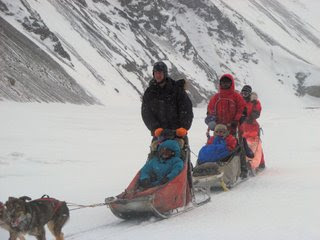
Three sleds of Student Mushers pulled by one team in traditional harnesses.
Our preferred hauling harness is a traditional X-back, full-length model. The pulling point is at the dog’s hind end, just above the base of the tail. Therefore, the dog will use its entire body to push into the harness and gain momentum. Since the dog is attached to the gangline at both the rear pulling point by a tugline and at the collar with a neckline, this system is definitely more confining. The dog has no option but to follow the steps of the dog in front of it. This keeps the team very straight and organized. In our opinion, this system enhances team strength to haul those heavier loads. It has the added advantage of team cohesiveness, when the dogs are hearing commands from different student mushers, a common occurrence during our Dog Mushing Adventures.

Teddy models a traditional X-back harness.
There are many other sled dog harness systems available. Some are designed for extreme hauling, some for sprint racing, some for skijoring. New ideas are always in the development stages. So far, the two systems mentioned above are our favorites. But, if you see any new and interesting concepts during your own research into harnesses, let us know. We are always open to new ideas.

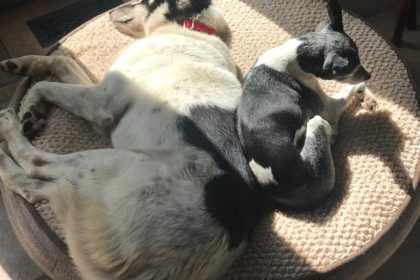



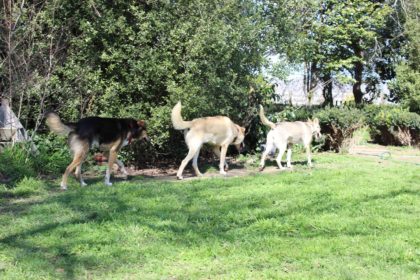
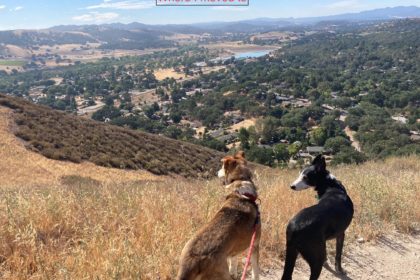
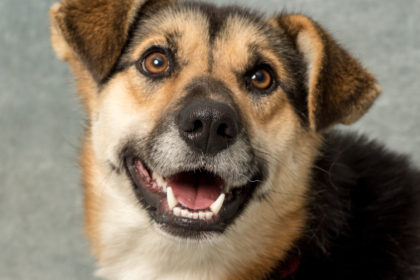

I really like your blogs that talk about a specific thing like harnesses. Just switched to half harnesses this week. Interesting the first time the dogs went out in them….I think they thought they wern’t really hooked up, but about 1/4 mile down the trail they looked like they loved it.
What types of rope are you using for your main line and tug lines? Is it just normal braided nylon or something?
Thanks,
Matt